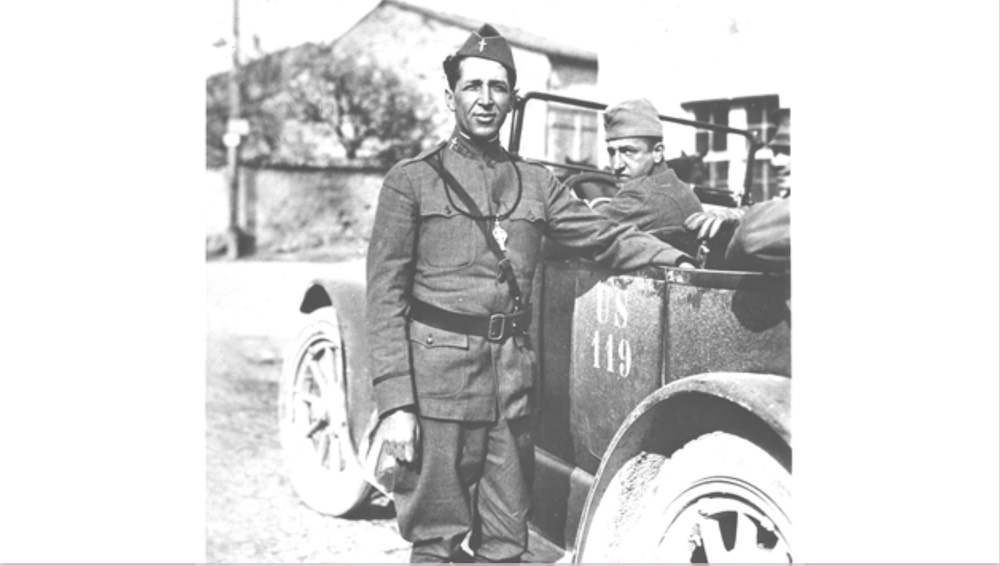During the month of January, the 52nd Lights for Peace flag to fly at the Fort Taber – Fort Rodman Military Museum honors the memory of Rev. Father John Baptist DeValles, a WWI Veteran who was awarded for “extraordinary heroism and exceptional devotion to his duty.”
He was born, Joa Baptista DeValles, on Aug. 29, 1879 on the island of Sao Miguel in the Azores, and emigrated to the United States at the age of two years old, eventually residing at 39 Ingram St., New Bedford. He attended local schools and studied for the priesthood. He was ordained in 1906, serving in local parishes in New Bedford and Fall River.
According to the War Records Dept., “When the United States entered World War I in 1917, despite being nearly 40 years old, (DeValles) set aside his comfortable life to volunteer as a chaplain through the Knights of Columbus and was attached to the Massachusetts National Guard’s 104th Infantry Regiment, 26th “Yankee” Division. He was appointed to First Lieutenant (1LT) Chaplain on July 17, 1918. The Yankee Division was organized from National Guard units throughout New England and as the first entire U.S. division to arrive in France, it saw action in every major campaign of the American Expeditionary Force (AEF).”
The AEF helped the French Army on the Western Front during the Aisne Offensive and the Meuse-Argonne Offensive. DeValles took part in the Defensive Champagne-Marne; Offensive Aisne-Marne; St. Mihiel; and Defensive Sectors: Rupt (Lorraine) and Troyon (Lorraine).
He was known as the “Angel of the trenches” often in “no man’s land,” comforting the injured and carrying the wounded to aid stations, administering to the dying. He made no distinction between allies or Germans.
Father DeValles returned to the United States with the Yankee Division in 1919 but died in May 1920 of abdominal cancer at St. Luke’s Hospital, New Bedford, MA at the age of 41, due to exposure to mustard gas in France. He was awarded the nation’s second highest military decoration, the Distinguished Service Cross, posthumously by Major General Clarence Edward, former Commanding General of the Yankee Division. “For extraordinary heroism in action near Apremont, Toul sector, France, April 10 to 13, 1918. Chaplain DeValles repeatedly exposed himself to heavy artillery and machine-gun fire in order to assist in the removal of the wounded from exposed points in advance of the lines. He worked for long periods of time with stretcher bearers in carrying wounded men to safety. Chaplain DeValles previously rendered gallant service in the Chemin des Dames sector, March 11, 1918, by remaining with a group of wounded during a heavy enemy bombardment.”
He was also awarded the foreign decorations of the French Croix de Guerre with gilt star, under General Order No. 736-A, dated April 26, 1918, 32nd French Army Corps, with the following citation: “Extraordinary heroism and exceptional devotion to his duty. Under uninterrupted enemy fire, did not cease to care for the wounded and to encourage to renewed efforts the men worn out by hard fighting.”
Some insight as to what the soldiers went through during WWI as documented by WWI letters explained that “there were no trenches in the area of the front, little wire and no shelters (dugouts). Rather, defenses were designed for open warfare and consisted of shallow foxholes covered with brush, positioned to provide mutually supporting fire along with numerous machine gun positions. The outpost line and principal resistance line were separated by a 1,000 yard artillery barrage zone designed to break up any attack that overran the outposts. Occupants of the outposts had the usual mission of fighting to the last man with no hope of reinforcement. At all hours, troops of the outpost line were fired on by machine guns and artillery of the German 7th Army. Food and water had to be carried to the forward troops by ration details through machine gun fire under cover of darkness. The troops suffered a high number of casualties due to heavy gas exposure.”
In October 1920, shortly after Chaplain DeValles’ death, the Katherine Street School in New Bedford was rededicated as the John B. DeValles School in his honor.
Linda Ferreira, of Empire Ford, researches the life histories of area residents. American flags are provided by Empire Ford. Flags are raised by the staff at Fort Taber – Fort Rodman Military Museum. Those who would like to honor a local veteran in the future can contact Ferreira at lferreira@empirefordinc.com.
 New Bedford Guide Your Guide to New Bedford and South Coast, MA
New Bedford Guide Your Guide to New Bedford and South Coast, MA









Hopefully, when new school is built replacing Devalles and another, Father Devalles bravery and service to our Country will continue to be honored.